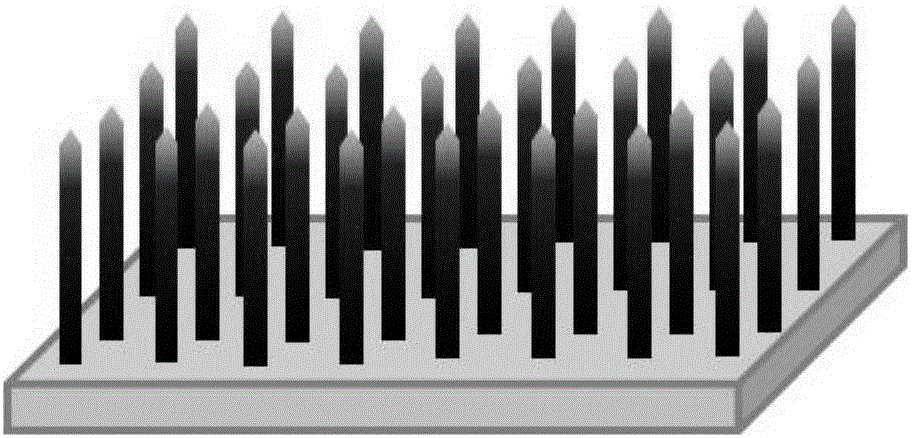Microneedle for hypertrophic scars and preparation method for microneedle
A hypertrophic scar and microneedle technology, applied in the field of biomedicine, can solve problems such as toxic reaction tissue and rejection
- Summary
- Abstract
- Description
- Claims
- Application Information
AI Technical Summary
Problems solved by technology
Method used
Image
Examples
preparation example Construction
[0026] The invention provides a method for preparing microneedles for hypertrophic scars, comprising:
[0027] 1) mixing the first polymer with the first solvent to obtain the first solution,
[0028] The first polymer is a crystalline polymer;
[0029] mixing a second polymer with a second solvent to obtain a second solution;
[0030] 2) pouring the first solution into a mold containing the micropore array, and vacuuming to obtain a mold filled with the micropores of the first solution;
[0031] 3) Adding the second solution into the mold with micropores filled with the first solution, and vacuuming to obtain microneedles for hypertrophic scars.
[0032] According to the present invention, the present invention mixes the first polymer with the first solvent to obtain the first solution; wherein, the first polymer is preferably poly-L-lactic acid, poly-D-lactic acid, polyhydroxybutyl ester homopolymer and One or more of the polyhydroxybutyrate pentyl ester copolymers, more ...
Embodiment 1
[0042] The crystalline polymer PLLA (0.5g) was used as a solute, and it was fully dissolved in a mixed solution of 12g of dichloromethane and 8g of 1,4-dioxane to prepare the first solution;
[0043] 0.5g PLGA and 15g dichloromethane solution were mixed to obtain a second solution;
[0044] 5g of the first solution is evenly poured on the porous ceramic microporous abrasive tool, immediately put into a downward vacuuming device, and vacuumize to ensure that the solution penetrates into the ceramic abrasive tool, and obtain a micropore-filled mold of the first solution;
[0045] Take out the mold filled with the micropores of the first solution, continue to pour several mL of the second solution evenly, and immediately put it into a porous ceramic device that is evacuated downward, the solvent evaporates, and after it is completely dried, a microneedle patch for hypertrophic scars is obtained. .
[0046] Immerse the microneedles for hypertrophic scars into the aqueous solution...
Embodiment 2
[0049] A crystalline polymer polyhydroxybutyrate homopolymer (0.4 g) was used as a solute, and it was fully dissolved in a mixed solution of 12 g of methylene chloride and 8 g of 1,4-dioxane to prepare a first solution;
[0050] 0.2g PLGA and 15g dichloromethane solution were mixed to obtain a second solution;
[0051] 5g of the first solution is evenly poured on the porous ceramic microporous abrasive tool, immediately put into a downward vacuuming device, and vacuumize to ensure that the solution penetrates into the ceramic abrasive tool, and obtain a micropore-filled mold of the first solution;
[0052] Take out the mold filled with the micropores of the first solution, continue to pour 5mL of the second solution evenly, and immediately put it into a porous ceramic device that is vacuumed downwards, the solvent evaporates, and after it is completely dried, a microneedle patch for hypertrophic scars is obtained.
[0053] Immerse the microneedles for hypertrophic scars into t...
PUM
| Property | Measurement | Unit |
|---|---|---|
| concentration | aaaaa | aaaaa |
| concentration | aaaaa | aaaaa |
| length | aaaaa | aaaaa |
Abstract
Description
Claims
Application Information
 Login to View More
Login to View More - R&D
- Intellectual Property
- Life Sciences
- Materials
- Tech Scout
- Unparalleled Data Quality
- Higher Quality Content
- 60% Fewer Hallucinations
Browse by: Latest US Patents, China's latest patents, Technical Efficacy Thesaurus, Application Domain, Technology Topic, Popular Technical Reports.
© 2025 PatSnap. All rights reserved.Legal|Privacy policy|Modern Slavery Act Transparency Statement|Sitemap|About US| Contact US: help@patsnap.com



